

User:Dolfrog. Dolfrog is my internet name and has been associated with my Auditory Processing Disorder (APD) research.

Since 1998, I have been trying to promote a greater understanding of APD to help my children who have this condition. During my research into the nature of APD I soon realised that I have lived with this condition from birth. List of writing systems. This is a list of writing systems (or scripts), classified according to some common distinguishing features.

The usual name of the script is given first; the name of the language(s) in which the script is written follows (in brackets), particularly in the case where the language name differs from the script name. Other informative or qualifying annotations for the script may also be provided. Alphabet. A standard set of letters that represent phonemes of a spoken language Edward Bernard's "Orbis eruditi", comparing all known alphabets as of 1689 The first fully phonemic script, the Proto-Canaanite script, later known as the Phoenician alphabet, is considered to be the first alphabet, and is the ancestor of most modern alphabets, including Arabic, Greek, Latin, Cyrillic, Hebrew, and possibly Brahmic.[1][2] Peter T.
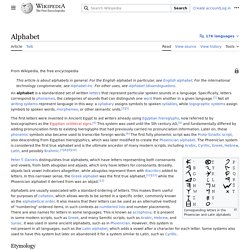
Auditory processing disorder. Auditory processing disorder (APD), also known as central auditory processing disorder (CAPD), is an umbrella term for a variety of disorders that affect the way the brain processes auditory information.[1] Individuals with APD usually have normal structure and function of the outer, middle and inner ear (peripheral hearing).
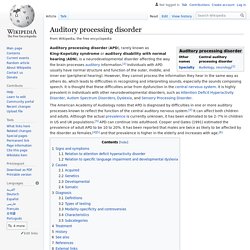
However, they cannot process the information they hear in the same way as others do, which leads to difficulties in recognizing and interpreting sounds, especially the sounds composing speech. It is thought that these difficulties arise from dysfunction in the central nervous system. Brainstorming. Brainstorming is a group creativity technique by which efforts are made to find a conclusion for a specific problem by gathering a list of ideas spontaneously contributed by its members.
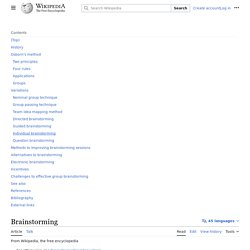
The term was popularized by Alex Faickney Osborn in the 1953 book Applied Imagination. Origin[edit] Advertising executive Alex F. Osborn began developing methods for creative problem solving in 1939. He was frustrated by employees’ inability to develop creative ideas individually for ad campaigns. Osborn's method[edit] brainstorming activity conducting. Cognitive map.
Overview[edit] Cognitive maps serve the construction and accumulation of spatial knowledge, allowing the "mind's eye" to visualize images in order to reduce cognitive load, enhance recall and learning of information.
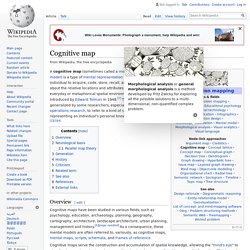
This type of spatial thinking can also be used as a metaphor for non-spatial tasks, where people performing non-spatial tasks involving memory and imaging use spatial knowledge to aid in processing the task.[6] Concept map. An Electricity Concept Map, an example of a concept map A concept map or conceptual diagram is a diagram that depicts suggested relationships between concepts.[1] It is a graphical tool that designers, engineers, technical writers, and others use to organize and structure knowledge.

A concept map typically represents ideas and information as boxes or circles, which it connects with labeled arrows in a downward-branching hierarchical structure. The relationship between concepts can be articulated in linking phrases such as causes, requires, or contributes to.[2] Dichotic listening. Dichotic Listening is a psychological test commonly used to investigate selective attention within the auditory system and is a subtopic of cognitive psychology and neuroscience.
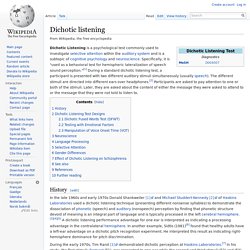
Specifically, it is "used as a behavioral test for hemispheric lateralization of speech sound perception. "[1] During a standard dichotic listening test, a participant is presented with two different auditory stimuli simultaneously (usually speech). The different stimuli are directed into different ears over headphones.[2] Participants are asked to pay attention to one or both of the stimuli. Later, they are asked about the content of either the message they were asked to attend to or the message that they were not told to listen to. History[edit] During the early 1970s, Tim Rand [3] demonstrated dichotic perception at Haskins Laboratories.[7] In his study, the first stimuli: formant (F1), was presented to one ear while the second and third stimuli:(F2) and (F3) formants, were presented to the opposite ear. Disability Discrimination Act 1995. The Disability Discrimination Act 1995 (c 50) (informally, and hereafter, the DDA) is an Act of the Parliament of the United Kingdom which has now been repealed and replaced by the Equality Act 2010, except in Northern Ireland where the Act still applies.
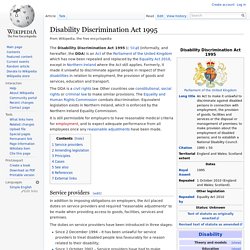
Formerly, it made it unlawful to discriminate against people in respect of their disabilities in relation to employment, the provision of goods and services, education and transport. The DDA is a civil rights law. Other countries use constitutional, social rights or criminal law to make similar provisions. The Equality and Human Rights Commission combats discrimination. Equivalent legislation exists in Northern Ireland, which is enforced by the Northern Ireland Equality Commission. Service providers[edit] In addition to imposing obligations on employers, the Act placed duties on service providers and required "reasonable adjustments" to be made when providing access to goods, facilities, services and premises.
Dyscalculia. Dyscalculia is difficulty in learning or comprehending arithmetic, such as difficulty in understanding numbers, learning how to manipulate numbers, and learning math facts. It is generally seen as a specific developmental disorder like dyslexia. Grapheme. The word grapheme is derived from Greek γράφω gráphō ("write"), and the suffix -eme, by analogy with phoneme and other names of emic units. The study of graphemes is called graphemics. Notation[edit] Graphemes are often notated within angle brackets, as 〈a〉, 〈B〉, etc.[1] This is analogous to the slash notation (/a/, /b/) used for phonemes, and the square bracket notation used for phonetic transcriptions ([a], [b]). History of writing. The history of writing is primarily the development of expressing language by letters or other marks[1] and also the study and description of these developments.
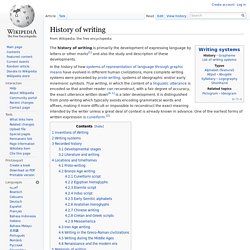
Language interpretation. This article is about interpretation of natural languages. For interpretation of programming languages, see Interpreted language. Interpretation or interpreting is the facilitating of oral or sign-language communication, either simultaneously or consecutively, between users of different languages. Translation studies is the systematic study of the theory, description and application of interpretation and translation.[1] An interpreter is a person who converts a thought or expression in a source language into an expression with a comparable meaning in a target language either simultaneously in "real time" or consecutively after one party has finished speaking. Latin alphabet. Alphabet used to write the Latin language The Latin or Roman alphabet is the set of letters originally used by the ancient Romans to write Latin. Etymology Evolution. List of languages by writing system.
Below is a list of languages sorted by writing system (by alphabetical order). Afaka syllabary[edit] Ndyuka (on occasion) Logogram. Logograms are commonly known also as "ideograms". Strictly speaking, however, ideograms represent ideas directly rather than words and morphemes, and none of the logographic systems described here is truly ideographic. Mnemonic. Orthography. Most significant languages in the modern era are written down, and for most such languages a standard orthography has been developed, often based on a standard variety of the language, and thus exhibiting less dialect variation than the spoken language.
Outline of communication. Phonogram (linguistics) Scotopic sensitivity syndrome. Train of thought. Visual thinking. Writing. Writing system. General properties[edit] Chinese characters (漢字) are morpho-syllabic. Each one represents a syllable with a distinct meaning, but some characters may have multiple meanings or pronunciations.